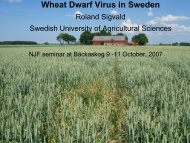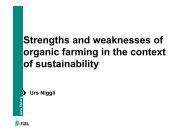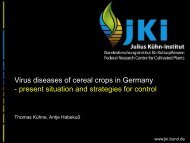measurement methods of soil, water, plant and fruit, in berry ... - NJF
measurement methods of soil, water, plant and fruit, in berry ... - NJF
measurement methods of soil, water, plant and fruit, in berry ... - NJF
You also want an ePaper? Increase the reach of your titles
YUMPU automatically turns print PDFs into web optimized ePapers that Google loves.
METEOROLOGICAL DATA FOR WARNING SYSTEMS AND<br />
FRUIT STORAGE<br />
Christer Tornéus<br />
Swedish Board <strong>of</strong> Agriculture<br />
christer.tornéus@sjv.se<br />
Summary<br />
Weather data, as a basis for estimat<strong>in</strong>g various biological developments, has become an<br />
important resource <strong>in</strong> our efforts to produce food with more environmental-friendly <strong>methods</strong>.<br />
Several s<strong>of</strong>t wares deal with <strong>plant</strong> diseases <strong>and</strong> pests or are used as decision support tools for<br />
<strong>plant</strong> nutrition management. Some s<strong>of</strong>t wares for weather data presentation <strong>and</strong> disease<br />
prediction are mentioned.<br />
A management system consists <strong>of</strong> three parts; a model based on biological research, a<br />
collect<strong>in</strong>g system for weather data <strong>and</strong> s<strong>of</strong>tware for comb<strong>in</strong><strong>in</strong>g those <strong>in</strong>to a user-friendly<br />
<strong>in</strong>terface.<br />
Ma<strong>in</strong>ly three different types <strong>of</strong> weather stations are used <strong>in</strong> Sweden; Metos, Adcon <strong>and</strong><br />
Campbell. Some discrim<strong>in</strong>at<strong>in</strong>g features are presented. They are used either as st<strong>and</strong>-alone<br />
<strong>in</strong>struments or <strong>in</strong> smaller networks. At least one <strong>of</strong> the systems has options that make it<br />
suitable for storage room monitor<strong>in</strong>g. Weather data can also be obta<strong>in</strong>ed from SMHI<br />
(Swedish Meteorological <strong>and</strong> Hydrological Institute). Whether the sensors should be placed <strong>in</strong><br />
or near the crop, or accord<strong>in</strong>g to the rules for “normal” stations used by public <strong>in</strong>stitutes like<br />
SMHI, is another important issue. A project (Lantmet) is go<strong>in</strong>g on with the ma<strong>in</strong> object to<br />
gather weather data <strong>in</strong> one place <strong>and</strong> make it accessible on the Internet.<br />
Other items discussed <strong>in</strong> this lecture are weak po<strong>in</strong>ts <strong>in</strong> the field part, especially leaf wetness<br />
sensors <strong>and</strong> relative air humidity sensors. Some systems calculate the leaf wetness periods <strong>and</strong><br />
there are two types <strong>of</strong> sensors used, with two different ways <strong>of</strong> present<strong>in</strong>g the leaf wetness<br />
status. The importance <strong>of</strong> high quality system ma<strong>in</strong>tenance <strong>and</strong> a validation system for the<br />
database is also emphasized.









